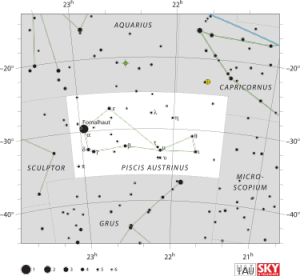Piscis Austrinus: Difference between revisions
No edit summary |
No edit summary |
||
| Line 1: | Line 1: | ||
[[File:375px-Piscis Austrinus IAU.svg (1).png|thumb|Piscis Austrinus]] | [[File:375px-Piscis Austrinus IAU.svg (1).png|thumb|Piscis Austrinus]] | ||
[[Piscis Austrinus]] (also known as Piscis Australis) is a constellation in the southern celestial hemisphere. The name isLatin for "the southern fish", in contrast with the larger constellation Pisces, which represents a pair of fishes. Prior to the 20th century, it was also known as Piscis Notius. Its only star brighter than 4th magnitude is Fomalhaut, which is a first-magnitude star and is the 18th brightest star in the night sky. | [[Piscis Austrinus]] (also known as Piscis Australis) is a constellation in the southern celestial hemisphere. The name isLatin for "the southern fish", in contrast with the larger constellation Pisces, which represents a pair of fishes. Prior to the 20th century, it was also known as Piscis Notius. Its only star brighter than 4th magnitude is Fomalhaut, which is a first-magnitude star and is the 18th brightest star in the night sky. | ||
Piscis Austrinus was one of the 48 constellations listed by the 2nd century astronomer Ptolemy, and it remains one of the 88 modern constellations. The stars of the modern constellation Grus once formed the "tail" of Piscis Austrinus. In 1597 (or 1598), Petrus Plancius carved out a separate constellation and named it after the crane. | Piscis Austrinus was one of the 48 constellations listed by the 2nd century astronomer Ptolemy, and it remains one of the 88 modern constellations. The stars of the modern constellation Grus once formed the "tail" of Piscis Austrinus. In 1597 (or 1598), Petrus Plancius carved out a separate constellation and named it after the crane. | ||
In Greek mythology, this constellation is known as the Great Fish and it is portrayed as swallowing the water being poured out by Aquarius, the water-bearer constellation. The two fish of the constellation Pisces are said to be the offspring of the Great Fish. In Egyptian mythology, this fish saved the life of the Egyptian goddess Isis, so she placed this fish and its descendants into the heavens as constellations of star, | In Greek mythology, this constellation is known as the Great Fish and it is portrayed as swallowing the water being poured out by Aquarius, the water-bearer constellation. The two fish of the constellation Pisces are said to be the offspring of the Great Fish. In Egyptian mythology, this fish saved the life of the Egyptian goddess Isis, so she placed this fish and its descendants into the heavens as constellations of star, | ||
Revision as of 02:18, 15 March 2015
Piscis Austrinus (also known as Piscis Australis) is a constellation in the southern celestial hemisphere. The name isLatin for "the southern fish", in contrast with the larger constellation Pisces, which represents a pair of fishes. Prior to the 20th century, it was also known as Piscis Notius. Its only star brighter than 4th magnitude is Fomalhaut, which is a first-magnitude star and is the 18th brightest star in the night sky.
Piscis Austrinus was one of the 48 constellations listed by the 2nd century astronomer Ptolemy, and it remains one of the 88 modern constellations. The stars of the modern constellation Grus once formed the "tail" of Piscis Austrinus. In 1597 (or 1598), Petrus Plancius carved out a separate constellation and named it after the crane.
In Greek mythology, this constellation is known as the Great Fish and it is portrayed as swallowing the water being poured out by Aquarius, the water-bearer constellation. The two fish of the constellation Pisces are said to be the offspring of the Great Fish. In Egyptian mythology, this fish saved the life of the Egyptian goddess Isis, so she placed this fish and its descendants into the heavens as constellations of star,
Piscis Austrinus is a constellation bordered by Capricornus to the northwest, Microscopium to the southwest, Grus to the south, Sculptor to the east, Aquarius to the north.Pisces Austrinus originated with the Babylonian constellation simply known as the Fish (MUL.KU).
Fomalhaut traditionally represents the mouth of the fish. Its companion Fomalhaut b was thought to be the first extrasolar planet ever detected by a visible light image, thanks to the Hubble Space Telescope, but infrared observations have since retracted this claim: it is instead a spherical cloud of dust. TW Piscis Austrini can be seen close by and is possibly associated with Fomalhaut as it lies within a light year of it. [1]
HGS Session References
HGS Sessions - Clearing Hyperspace Phantom Matrix - 3/12/2015 [2]
References
Found in HGS Manual on Page 108
Found in HGS Manual on Page 115


